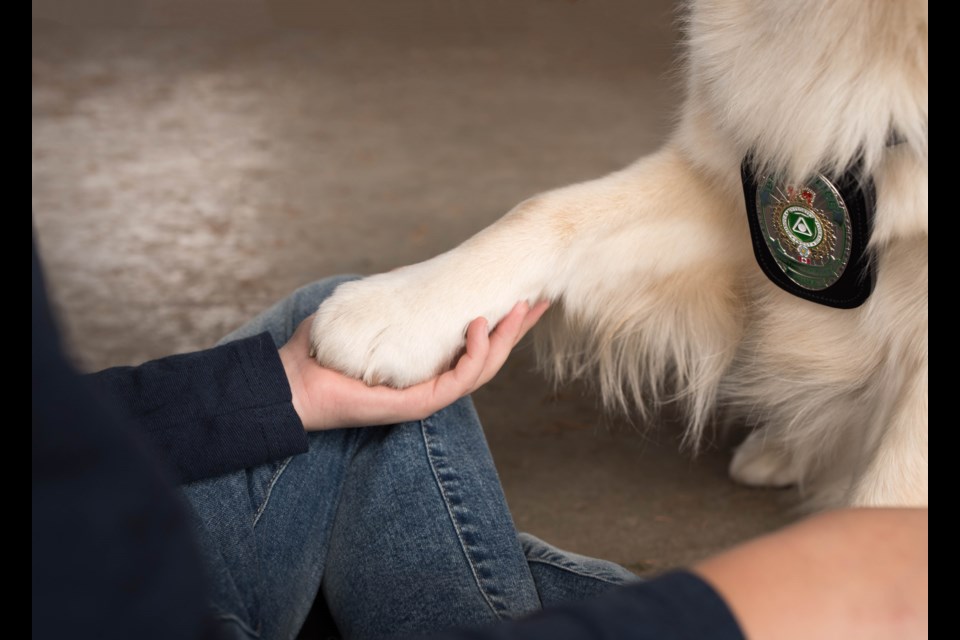You’ve probably seen a dedicated doggo help a visually impaired person cross a street, but did you know there’s a whole fleet of professional pooches lending their paws to people in the province?
Thanks to a few expert organizations, service dogs in British Columbia are doing more jobs than ever, and helping to improve lives in a wider range of situations.
Today, more than 200 service dogs in the province are helping people in hospitals, classrooms and even courtrooms.
Here’s a guide to B.C.’s most supportive working canines.
What kinds of service dogs are there?
As already mentioned, guide dogs for the blind or visually impaired are trained to help people navigate the world who can’t rely on visual cues. The term “seeing eye dog” is actually trademarked by an American organization, so it isn’t widely used.
Similarly, hearing dogs detect when particular sounds happen – like a knock at the door, or a beeping smoke detector – and either alert their human partner or take them to the source.
There are two types of mobility dogs. Standard mobility dogs accompany people in wheelchairs, helping them pick things off the ground, take off jackets and open the fridge. Bracing dogs wear a specialized harness to assist people with less mobility in their lower extremities, helping them to balance while doing tasks like climbing stairs.
Autism service dogs accompany children aged 3-10 with profound autism. These pups wear a special harness that tethers them to the child, keeping them safe by preventing bolting. Other benefits include reduced stress and anxiety, as well as encouraging more social interaction.
For first responders and veterans, operational stress injury and PTSD service dogs provide important physical, calming and grounding skills. These highly trained animals are selected for their awareness and positive responses to human emotions like fear.
Through Vancouver Island Compassion Dogs, a division of BC and Alberta Guide Dogs (BCAGD), recipients matched with an OSI-PTSD canine undergo a year-long program to help the person reintegrate back in their community.
Lastly, there are three types of facility dogs, which unlike most other service pooches work with multiple people instead of a dedicated recipient. Gaia, who works at Canuck Place Children’s Hospice, is a health and wellness facility dog. Trained by Pacific Assistance Dogs Society (PADS), she’s there to provide emotional support and comfort.
Justice facility dogs work with people who have experienced crimes, and can be with them through grief counselling and the entire judicial process.
To help children with extra support needs, educational facility dogs are placed in schools with teachers or counsellors.
What does it take to get a puppy into the working world?
Puppies are born into their organizations under the supervision of staff, then at around seven weeks old, they go to volunteer puppy-raising homes.
At around 15-18 months, they go in for training with professional instructors, but still live in homes.
"All of our dogs live in homes throughout their lives," BCAGD CEO William Thorton said. "We don't kennel dogs."
During or towards the end of their training, the dogs are typically placed with a person and complete a couple of weeks’ more of training with their recipient.
For guide dogs, the training process can take almost two years before graduation.
Both BCAGD and PADS adhere to provincial law and international standards for breeding, raising and training.
Do all dogs go to graduation?
Most dogs graduate. Some that require extra time can go back for more training.
But professional life isn’t for every pup, explained PADS spokesperson Meredith Areskoug.
“If they don't want to do this, then we don't force them,” she said. “They are living, breathing creatures. So what we do is we re-career them.”
Some dogs are just meant to be pets. PADS has a release program where people can adopt these or former working canines. The organization also has a VIP (very important pet program) for people who might not be able to apply for a service dog, but would like a well-trained doggo in their home to help with a family member who needs extra support.
Is there a preferred breed?
Almost all service and guide dogs are Labrador or golden retrievers, or a cross between the two.
“They just have the temperament, the food motivation, and the overall kind of aptitude for this sort of work,” Areskoug said.
Their temperament is doubly important because working dogs need to pass a public access test. To be well-behaved in all situations, they need to ignore food on the floor, strangers, and even squirrels.
In many situations, the goal is for people not to realize the dog is there. "Some people don't like dogs," Areskoug added.
How much does it cost to get a service dog?
While it can cost upwards of $35,000 to get a dog to the workforce, recipients pay nothing. BCAGD and PADS are non-profit organizations, relying on donations and sponsorships.
There’s no cost associated with VIP dogs either, but donations are encouraged.
Patrons can sponsor puppies or litters, and name the dogs. Advanced training of particular dogs can also be sponsored.

.jpeg;w=120;h=80;mode=crop)


